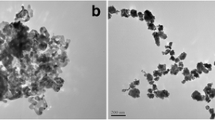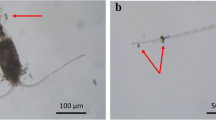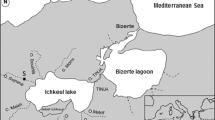Abstract
Although the toxicological impact of metal oxide nanoparticles has been studied for the last few decades on aquatic organisms, the exact mechanism of action is still unclear. The fate, behavior, and biological activity of nanoparticles are dependent on physicochemical factors like size, shape, surface area, and stability in the medium. This study deals with the effect of nano and bulk CeO2 particles on marine microcrustacean, Artemia salina. The primary size was found to be 15 ± 3.5 and 582 ± 50 nm for nano and bulk CeO2 (TEM), respectively. The colloidal stability and sedimentation assays showed rapid aggregation of bulk particles in seawater. Both the sizes of CeO2 particles inhibited the hatching rate of brine shrimp cyst. Nano CeO2 was found to be more toxic to A. salina (48 h LC50 38.0 mg/L) when compared to bulk CeO2 (48 h LC50 92.2 mg/L). Nano CeO2-treated A. salina showed higher oxidative stress (ROS) than those treated with the bulk form. The reduction in the antioxidant activity indicated an increase in oxidative stress in the cells. Higher acetylcholinesterase activity (AChE) was observed upon exposure to nano and bulk CeO2 particles. The uptake and accumulation of CeO2 particles were increased with respect to the concentration and particle size. Thus, the above results revealed that nano CeO2 was more lethal to A. salina as compared to bulk particles.







Similar content being viewed by others
References
Adam N, Leroux F, Knapen D, Bals S, Blust R (2015) The uptake and elimination of ZnO and CuO nanoparticles in Daphnia magna under chronic exposure scenarios. Water Res 68:249–261
Afifi M, Saddick S, Zinada OAA (2016): Toxicity of silver nanoparticles on the brain of Oreochromis niloticus and Tilapia zillii. Saudi J Biol Sci 23:754–760
Ali D, Ali H (2015) Susceptibility of the freshwater pulmonate snail Lymnea luteola L. to copper oxide nanoparticle. Toxicol Environ Chem 97:576–587
Angel BM, Vallotton P, Apte SC (2015) On the mechanism of nanoparticulate CeO2 toxicity to freshwater algae. Aquat Toxicol 168:90–97
Arnold M, Badireddy A, Wiesner M, Di Giulio R, Meyer J (2013) Cerium oxide nanoparticles are more toxic than equimolar bulk cerium oxide in Caenorhabditis elegans. Arch Environ Contam Toxicol 65:224–233
Artells E, Issartel J, Auffan M, Borschneck D, Thill A, Tella M, Brousset L, Rose J, Bottero J-Y, Thiéry A, Shah V (2013) Exposure to Cerium Dioxide Nanoparticles Differently Affect Swimming Performance and Survival in Two Daphnid Species. PLoS ONE 8(8):e71260
Arulvasu C, Jennifer SM, Prabhu D, Chandhirasekar D (2014) Toxicity effect of silver nanoparticles in brine shrimp Artemia. Sci World J 2014 1–10 (e256919)
Ates M, Daniels J, Arslan Z, Farah IO, Rivera HF (2013) Comparative evaluation of impact of Zn and ZnO nanoparticles on brine shrimp (Artemia salina) larvae: effects of particle size and solubility on toxicity. Environ Sci Process Impacts 15:225–233
Auffan M, Bertin D, Chaurand P, Pailles C, Dominici C, Rose J, Bottero J-Y, Thiery A (2013) Role of molting on the biodistribution of CeO 2 nanoparticles within Daphnia pulex. Water Res 47:3921–3930
Badawy AME, Luxton TP, Silva RG, Scheckel KG, Suidan MT, Tolaymat TM (2010) Impact of environmental conditions (pH, ionic strength, and electrolyte type) on the surface charge and aggregation of silver nanoparticles suspensions. Environ Sci Technol 44:1260–1266
Bagnyukova TV, Storey KB, Lushchak VI (2005) Adaptive response of antioxidant enzymes to catalase inhibition by aminotriazole in goldfish liver and kidney. Comp Biochem Physiol B: Biochem Mol Biol 142:335–341
Bai W, Zhang Z, Tian W, He X, Ma Y, Zhao Y, Chai Z (2010) Toxicity of zinc oxide nanoparticles to zebrafish embryo: a physicochemical study of toxicity mechanism. J Nanopart Res 12:1645–1654
Baird DJ, Brown SS, Lagadic L, Liess M, Maltby L, Moreira-Santos M, Schulz R, Scott GI (2007) In situ-based effects measures: determining the ecological relevance of measured responses. Integr Environ Assess Manag 3:259–267
Bhuvaneshwari M, Iswarya V, Nagarajan R, Chandrasekaran N, Mukherjee A (2016) Acute toxicity and accumulation of ZnO NPs in Ceriodaphnia Dubia: relative contributions of dissolved ions and particles. Aquat Toxicol 177:494–502
Bhuvaneshwari M, Sagar B, Doshi S, Chandrasekaran N, Mukherjee A (2017) Comparative study on toxicity of ZnO and TiO2 nanoparticles on Artemia salina: effect of pre-UV-A and visible light irradiation. Environ Sci Pollut Res 24:5633–5646
Bradford MM (1976) A rapid and sensitive method for the quantitation of microgram quantities of protein utilizing the principle of protein-dye binding. Anal Biochem 72(1-2):248–254
Casals E, Pfaller T, Duschl A, Oostingh GJ, Puntes V (2010) Time evolution of the nanoparticle protein corona. ACS Nano 4:3623–3632
Chinnapongse SL, MacCuspie RI, Hackley VA (2011) Persistence of singly dispersed silver nanoparticles in natural freshwaters, synthetic seawater, and simulated estuarine waters. Sci Total Environ 409:2443–2450
Conway JR, Hanna SK, Lenihan HS, Keller AA (2014) Effects and implications of trophic transfer and accumulation of CeO2 nanoparticles in a marine mussel. Environ Sci Technol 48:1517–1524
Dahle JT, Arai Y (2015) Environmental geochemistry of cerium: applications and toxicology of cerium oxide nanoparticles. Int J Environ Res Public Health 12:1253–1278
Ellman GL, Courtney KD, Andres V, Featherstone RM (1961) A new and rapid colorimetric determination of acetylcholinesterase activity. Biochem Pharmacol 7:88–95
Engenheiro EL, Hankard PK, Sousa JP, Lemos MF, Weeks JM, Soares AM (2005) Influence of dimethoate on acetylcholinesterase activity and locomotor function in terrestrial isopods. Environ Toxicol Chem 24:603–609
Feswick A, Griffitt RJ, Siebein K, Barber D (2013) Uptake, retention and internalization of quantum dots in Daphnia is influenced by particle surface functionalization. Aquat Toxicol 130:210–218
Gambardella C, Aluigi MG, Ferrando S, Gallus L, Ramoino P, Gatti AM, Rottigni M, Falugi C (2013) Developmental abnormalities and changes in cholinesterase activity in sea urchin embryos and larvae from sperm exposed to engineered nanoparticles. Aquat Toxicol 130:77–85
Gambardella C, Mesarič T, Milivojević T, Sepčić K, Gallus L, Carbone S, Ferrando S, Faimali M (2014) Effects of selected metal oxide nanoparticles on Artemia salina larvae: evaluation of mortality and behavioural and biochemical responses. Environ Monit Assess 186:4249–4259
Garaud M, Trapp J, Devin S, Cossu-Leguille C, Pain-Devin S, Felten V, Giamberini L (2015) Multibiomarker assessment of cerium dioxide nanoparticle (nCeO 2) sublethal effects on two freshwater invertebrates, Dreissena polymorpha and Gammarus roeseli. Aquat Toxicol 158:63–74
García MA (2011) Surface plasmons in metallic nanoparticles: fundamentals and applications. J Phys D Appl Phys 44:283001
Gottfredsen RH, Larsen UG, Enghild JJ, Petersen SV (2013) Hydrogen peroxide induce modifications of human extracellular superoxide dismutase that results in enzyme inhibition. Redox Biol 1:24–31
Gupta GS, Kumar A, Shanker R, Dhawan A (2016) Assessment of agglomeration, co-sedimentation and trophic transfer of titanium dioxide nanoparticles in a laboratory-scale predator-prey model system. Sci Rep 6:31422
Heckert EG, Seal S, Self WT (2008) Fenton-like reaction catalyzed by the rare earth inner transition metal cerium. Environmental science & technology 42:5014–5019
Hund-Rinke K, Simon M (2006) Ecotoxic Effect of Photocatalytic Active Nanoparticles (TiO2) on Algae and Daphnids (8 pp). Environ Sci Pollut Res Int 13(4):225–232
Jayaseelan C, Rahuman AA, Ramkumar R, Perumal P, Rajakumar G, Kirthi AV, Santhoshkumar T, Marimuthu S (2014) Effect of sub-acute exposure to nickel nanoparticles on oxidative stress and histopathological changes in Mozambique tilapia, Oreochromis mossambicus. Ecotoxicol Environ Saf 107:220–228
Jemec A, Tišler T, Drobne D, Sepčić K, Jamnik P, Roš M (2008) Biochemical biomarkers in chronically metal-stressed daphnids. Comp Biochem Physiol C Toxicol Pharmacol 147:61–68
Jemec A, Djinović P, Črnivec IGO, Pintar A (2015) The hazard assessment of nanostructured CeO2-based mixed oxides on the zebrafish Danio rerio under environmentally relevant UV-A exposure. Sci Total Environ 506-507:272–278
Johari S, Kalbassi M, Soltani M, Yu I (2013) Toxicity comparison of colloidal silver nanoparticles in various life stages of rainbow trout (Oncorhynchus mykiss). Iran J Fish Sci 12:76–95
Johnston BD, Scown TM, Moger J, Cumberland SA, Baalousha M, Linge K, van Aerle R, Jarvis K, Lead JR, Tyler CR (2010) Bioavailability of nanoscale metal oxides TiO2, CeO2, and ZnO to fish. Environ Sci Technol 44:1144–1151
Kaszuba M, McKnight D, Connah MT, McNeil-Watson FK, Nobbmann U (2008) Measuring sub nanometre sizes using dynamic light scattering. J Nanopart Res 10:823–829
Keller AA, Wang H, Zhou D, Lenihan HS, Cherr G, Cardinale BJ, Miller R, Ji Z (2010) Stability and aggregation of metal oxide nanoparticles in natural aqueous matrices. Environ Sci Technol 44:1962–1967
Kono Y, M-a T, Asada K (1979) Superoxide dismutases from kidney bean leaves. Plant Cell Physiol 20:1229–1235
Krishnamoorthy K, Veerapandian M, Zhang L-H, Yun K, Kim SJ (2014) Surface chemistry of cerium oxide nanocubes: Toxicity against pathogenic bacteria and their mechanistic study. J Ind Eng Chem 20(5):3513–3517
Kuang Y, He X, Zhang Z, Li Y, Zhang H, Ma Y, Wu Z, Chai Z (2011) Comparison Study on the Antibacterial Activity of Nano- or Bulk-Cerium Oxide. J Nanosci Nanotechnol 11(5):4103–4108
Lahive E, Jurkschat K, Shaw BJ, Handy RD, Spurgeon DJ, Svendsen C (2014) Toxicity of cerium oxide nanoparticles to the earthworm Eisenia fetida: subtle effects. Environ Chem 11:268–278
Leung YH, Yung MM, Ng AM, Ma AP, Wong SW, Chan CM, Ng YH, Djurišić AB, Guo M, Wong MT (2015): Toxicity of CeO 2 nanoparticles–the effect of nanoparticle properties. Journal of Photochemistry and Photobiology B: Biology 145: 48–59
Lin W, Y-w H, Zhou X-D, Ma Y (2006) Toxicity of cerium oxide nanoparticles in human lung cancer cells. Int J Toxicol 25:451–457
Mannervik B, Nise G (1969) Synthesis and some reactions of the pantetheine-glutathione mixed disulfide. Arch Biochem Biophys 134:90–94
Moiseenko T, Kudryavtseva L (2001) Trace metal accumulation and fish pathologies in areas affected by mining and metallurgical enterprises in the kola region, Russia. Environ Pollut 114:285–297
OECD (2013) Guideline for testing of chemicals, 236. In: Fish embryo acute toxicity(FET) test. France, OECD, Paris Available at: http://www.oecd.org
OECD 202 (2004) Guideline for testing of chemicals. ‘Daphnia sp., acute immobilisation test. OECD, Paris
Park E-J, Choi J, Park Y-K, Park K (2008) Oxidative stress induced by cerium oxide nanoparticles in cultured BEAS-2B cells. Toxicology 245:90–100
Pauluhn J (2009) Pulmonary toxicity and fate of agglomerated 10 nm and 40 nm aluminum oxyhydroxides (AlOOH) following 4-week inhalation exposure of rats: toxic effects are determined by agglomerated, not primary particle size. Toxicol Sci 109:152–67
Pelletier DA, Suresh AK, Holton GA, McKeown CK, Wang W, Gu B, Mortensen NP, Allison DP, Joy DC, Allison MR, Brown SD, Phelps TJ, Doktycz MJ (2010) Effects of Engineered Cerium Oxide Nanoparticles on Bacterial Growth and Viability. Appl Environ Microbiol 76(24):7981–7989
Pulido-Reyes G, Rodea-Palomares I, Das S, Sakthivel TS, Leganes F, Rosal R, Seal S, Fernández-Piñas F (2015) Untangling the biological effects of cerium oxide nanoparticles: the role of surface valence states. Sci Rep 5
Rogers NJ, Franklin NM, Apte SC, Batley GE, Angel BM, Lead JR, Baalousha M (2010) Physico-chemical behaviour and algal toxicity of nanoparticulate CeO2 in freshwater. Environ Chem 7:50–60
Röhder LA, Brandt T, Sigg L, Behra R (2014) Influence of agglomeration of cerium oxide nanoparticles and speciation of cerium (III) on short term effects to the green algae Chlamydomonas reinhardtii. Aquat Toxicol 152:121–130
Rosenkranz P, Chaudhry Q, Stone V, Fernandes TF (2009) A comparison of nanoparticle and fine particle uptake by Daphnia magna. Environ Toxicol Chem 28:2142–2149
Saddick S, Afifi M, Zinada OAA (2015): Effect of zinc nanoparticles on oxidative stress-related genes and antioxidant enzymes activity in the brain of Oreochromis niloticus and Tilapia zillii. Saudi J Biol Sci. https://doi.org/10.1016/j.sjbs.2015.10.021
Sano K, Inohaya K, Kawaguchi M, Yoshizaki N, Iuchi I, Yasumasu S (2008) Purification and characterization of zebrafish hatching enzyme—an evolutionary aspect of the mechanism of egg envelope digestion. FEBS J 275:5934–5946
Stebounova LV, Guio E, Grassian VH (2011) Silver nanoparticles in simulated biological media: a study of aggregation, sedimentation, and dissolution. J Nanopart Res 13:233–244
Ulm L, Krivohlavek A, Jurašin D, Ljubojević M, Šinko G, Crnković T, Žuntar I, Šikić S, Vrček IV (2015) Response of biochemical biomarkers in the aquatic crustacean Daphnia magna exposed to silver nanoparticles. Environ Sci Pollut Res 22:19990–19999
Van der Oost R, Beyer J, Vermeulen NP (2003) Fish bioaccumulation and biomarkers in environmental risk assessment: a review. Environ Toxicol Pharmacol 13:57–149
Wang H, Wick RL, Xing B (2009a) Toxicity of nanoparticulate and bulk ZnO, Al 2 O 3 and TiO 2 to the nematode Caenorhabditis elegans. Environ Pollut 157:1171–1177
Wang J, Wang W-X (2014) Low bioavailability of silver nanoparticles presents trophic toxicity to marine medaka (Oryzias melastigma). Environ Sci Technol 48:8152–8161
Wang Z, Zhao J, Li F, Gao D, Xing B (2009b) Adsorption and inhibition of acetylcholinesterase by different nanoparticles. Chemosphere 77:67–73
Ward JE, Kach DJ (2009) Marine aggregates facilitate ingestion of nanoparticles by suspension-feeding bivalves. Mar Environ Res 68:137–142
Xia B, Zhu L, Han Q, Sun X, Chen B, Qu K (2017) Effects of TiO 2 nanoparticles at predicted environmental relevant concentration on the marine scallop Chlamys farreri: an integrated biomarker approach. Environ Toxicol Pharmacol 50:128–135
Xuereb B, Lefèvre E, Garric J, Geffard O (2009) Acetylcholinesterase activity in Gammarus fossarum (Crustacea Amphipoda): linking AChE inhibition and behavioural alteration. Aquat Toxicol 94:114–122
Yang X, Pan H, Wang P, Zhao F-J (2017) Particle-specific toxicity and bioavailability of cerium oxide (CeO 2) nanoparticles to Arabidopsis thaliana. J Hazard Mater 322:292–300
Yu R, Wu J, Liu M, Zhu G, Chen L, Chang Y, Lu H (2016) Toxicity of binary mixtures of metal oxide nanoparticles to Nitrosomonas europaea. Chemosphere 153:187–197
Zhang Y, Chen Y, Westerhoff P, Hristovski K, Crittenden JC (2008) Stability of commercial metal oxide nanoparticles in water. Water Res 42:2204–2212
Zhu X, Wang J, Zhang X, Chang Y, Chen Y (2009) The impact of ZnO nanoparticle aggregates on the embryonic development of zebrafish (Danio rerio). Nanotechnology 20:195103
Zhu X, Wang J, Zhang X, Chang Y, Chen Y (2010) Trophic transfer of TiO 2 nanoparticles from daphnia to zebrafish in a simplified freshwater food chain. Chemosphere 79:928–933
Acknowledgements
We acknowledge VIT University for providing the required facilities for this study.
Author information
Authors and Affiliations
Corresponding author
Ethics declarations
Conflict of interest
The authors declare that they have no competing interests.
Additional information
Responsible editor: Thomas D. Bucheli
Electronic supplementary material
ESM 1
(DOCX 2721 kb)
Rights and permissions
About this article
Cite this article
Sugantharaj David, E.M.D., Madurantakam Royam, M., Rajamani Sekar, S.K. et al. Toxicity, uptake, and accumulation of nano and bulk cerium oxide particles in Artemia salina . Environ Sci Pollut Res 24, 24187–24200 (2017). https://doi.org/10.1007/s11356-017-9975-4
Received:
Accepted:
Published:
Issue Date:
DOI: https://doi.org/10.1007/s11356-017-9975-4




